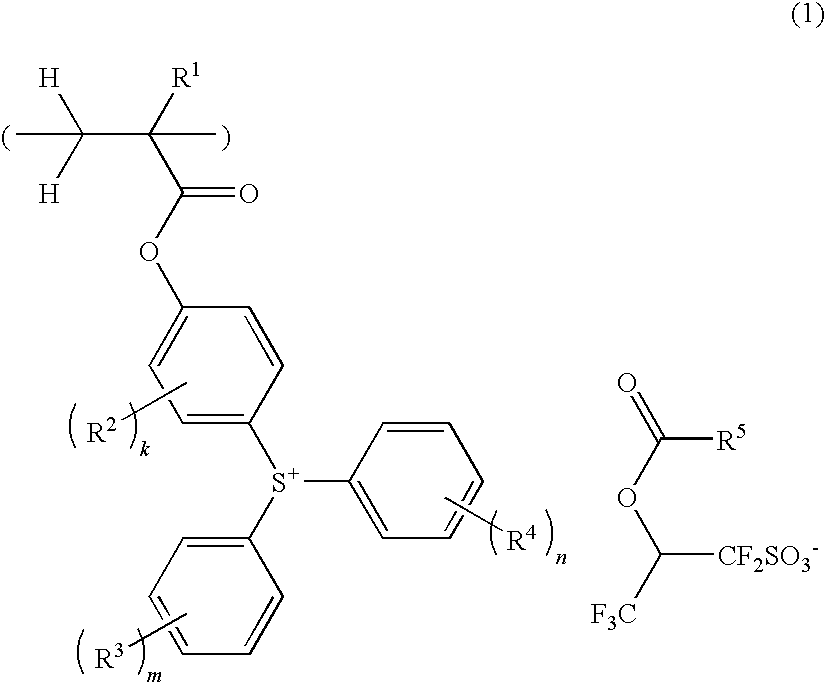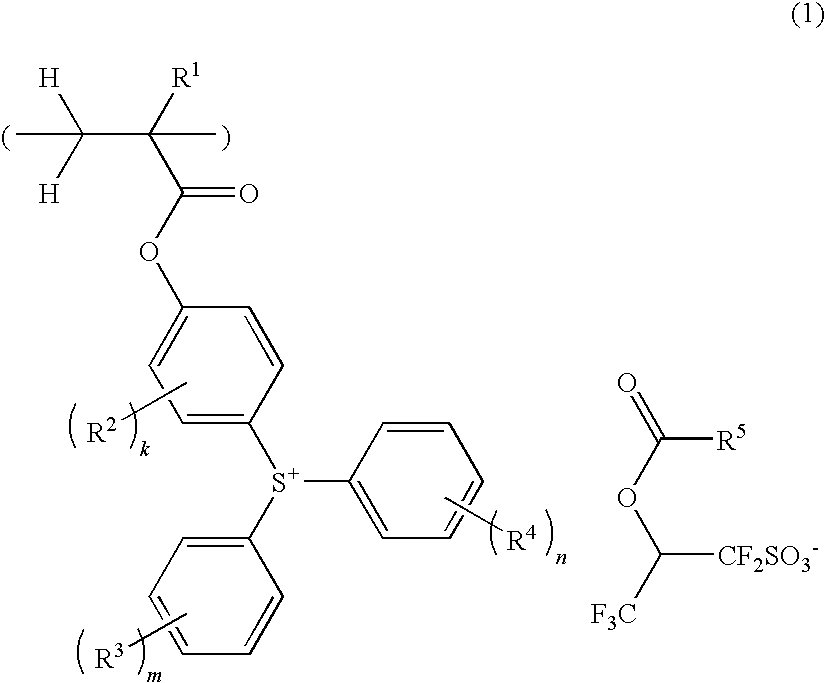Sulfonium salt-containing polymer, resist composition, and patterning process
a technology of sulfonium salt and polymer, applied in the direction of photosensitive materials, instruments, photomechanical equipment, etc., can solve the problems of insufficient acid strength, failure of resolution, and several lags in the development of the material, and achieve high acidity, facilitate efficient scission of acid labile groups, and high resolution
- Summary
- Abstract
- Description
- Claims
- Application Information
AI Technical Summary
Benefits of technology
Problems solved by technology
Method used
Image
Examples
synthesis example 1-1
[0237]Synthesis of Polymer 1
[0238]In a nitrogen blanket, a flask was charged with 2.68 g of 4-acryloyloxyphenyldiphenylsulfonium 1,1,3,3,3-pentafluoro-2-(1-adamantanecarbonyloxy)propane-1-sulfonate, 3.05 g of 3-ethyl-3-exo-tetracyclo[4.4.0.12,5.17,10]-dodecanyl methacrylate, 1.75 g of 3-hydroxy-1-adamantyl methacrylate, 2.52 g of tetrahydro-2-oxo-4-furanyl methacrylate, 304 mg of 2,2′-azobisisobutyronitrile, and 17.5 g of methyl ethyl ketone (MEK) to form a monomer solution. In a nitrogen blanket, 5.83 g of MEK was admitted into another flask and heated up to 80° C with stirring. With stirring, the monomer solution was added dropwise to the hot MEK over 4 hours. After the completion of dropwise addition, the polymerization solution was stirred for a further 2 hours while maintaining the temperature of 80° C. It was then cooled to room temperature. With vigorous stirring, the polymerization solution was added dropwise to a solvent mixture of 90 g hexane and 10 g MEK, whereupon a copo...
synthesis example 1-49
[0243]Synthesis of Polymer 49
[0244]Polymer 43 was reacted with 1-chloro-1-methoxy-2-methylpropane under basic conditions, obtaining Polymer 49.
[0245]With respect to the deprotection and protection of derivatives in Synthesis Examples 1-43 to 49, 64, and 65, reference should be made to JP-A 2004-115630 and JP-A 2005-8766.
TABLE 1Unit 1Unit 2Unit 3Unit 4Unit 5Unit 6Resin(ratio)(ratio)(ratio)(ratio)(ratio)(ratio)Synthesis Example1-1Polymer 11A (0.11)2A (0.29)3A (0.21)4A (0.39)1-2Polymer 21B (0.11)2A (0.29)3A (0.21)4A (0.39)1-3Polymer 31D (0.11)2A (0.29)3A (0.21)4A (0.39)1-4Polymer 41E (0.11)2A (0.29)3A (0.21)4A (0.39)1-5Polymer 51A (0.31)2A (0.38)4D (0.31)1-6Polymer 61A (0.31)2A (0.29)5B (0.40)1-7Polymer 71A (0.11)2A (0.23)3A (0.24)4D (0.33)5A (0.09)1-8Polymer 81A (0.11)2A (0.23)3A (0.24)4D (0.33)5B (0.09)1-9Polymer 91A (0.11)2A (0.23)3A (0.24)4D (0.33)5C (0.09)1-10Polymer 101F (0.11)2A (0.23)3A (0.24)4D (0.33)5D (0.09)1-11Polymer 111A (0.10)2A (0.30)3A (0.25)4A (0.25)4E (0.10)1-12Polym...
PUM
| Property | Measurement | Unit |
|---|---|---|
| wavelength | aaaaa | aaaaa |
| feature size | aaaaa | aaaaa |
| wavelength | aaaaa | aaaaa |
Abstract
Description
Claims
Application Information
 Login to View More
Login to View More - R&D
- Intellectual Property
- Life Sciences
- Materials
- Tech Scout
- Unparalleled Data Quality
- Higher Quality Content
- 60% Fewer Hallucinations
Browse by: Latest US Patents, China's latest patents, Technical Efficacy Thesaurus, Application Domain, Technology Topic, Popular Technical Reports.
© 2025 PatSnap. All rights reserved.Legal|Privacy policy|Modern Slavery Act Transparency Statement|Sitemap|About US| Contact US: help@patsnap.com



